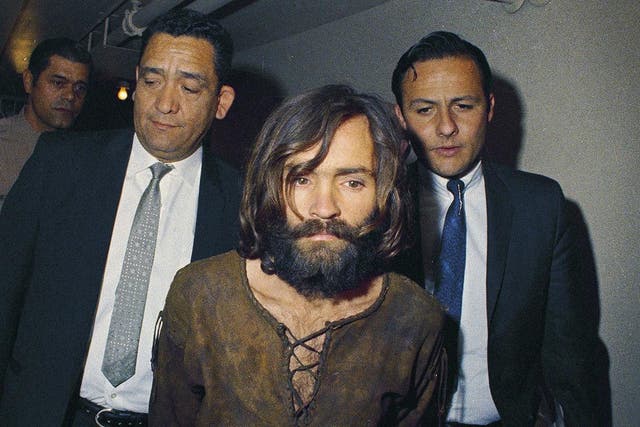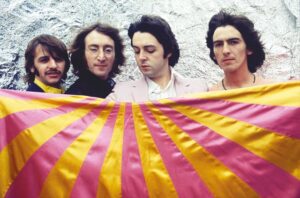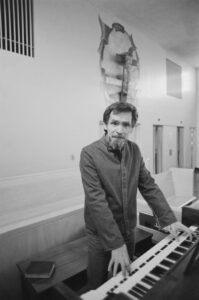
On August 9, 1969, the writing on the wall for the idealism of the 1960s was smeared in blood. “PIG,” it read, scrawled on the front door of 10050 Cielo Drive in Los Angeles, where pregnant actress Sharon Tate and four others had been brutally murdered. The following night, the walls of another home on Waverly Drive bore more sinister graffiti: “RISE,” “DEATH TO PIGS,” and, misspelled on the refrigerator, “HEALTER SKELTER.” These chilling words marked the infamous killings orchestrated by Charles Manson and his cult, The Family, in a twisted bid to ignite an apocalyptic race war.
Manson, who planned and ordered the murders, believed these deaths would be blamed on African Americans, ultimately sparking a race war. His delusion was rooted in a bizarre interpretation of The Beatles’ 1968 White Album, which he claimed contained coded messages about an impending conflict. Particularly, John Lennon’s nihilistic songs on the double album, with their dark, sparse tone, fueled Manson’s belief that The Beatles were speaking directly to him. He would later tell *Rolling Stone* that “Revolution 9,” an avant-garde piece from the album, was a reference to Revelations 9 from the Bible, which speaks of a “bottomless pit.” Manson interpreted this as a directive to hide with his Family in a cave in Death Valley while the world descended into chaos.
“It was the Beatles’ ‘Revolution 9’ that turned me on to it,” Manson said. “It predicts the overthrow of the Establishment. The pit will be opened, and that’s when it will all come down. A third of all mankind will die.”
His interpretations of the album were as delusional as they were dangerous. For instance, he believed Lennon’s “Glass Onion” foretold a wall of water that would protect The Family in the desert, while “Blackbird” and “Rocky Raccoon” were seen as prophecies of a black American uprising. George Harrison’s “Piggies” was adopted as inspiration for Manson’s open discussion of killing the wealthy. Most notably, Paul McCartney’s “Helter Skelter,” a frenetic rock track, became Manson’s rallying cry for the coming apocalypse. “‘Helter Skelter’ is confusion,” Manson famously said during his trial, “and confusion is coming down fast.”
Former Family member Dianne Lake confirmed this in her book *Member of the Family*, recalling how the song became their code for the race war and coming end times. “It sounded like chaos and destruction,” Lake wrote. “From then on, the song title stood as our not-so-secret code name for the race war between the blacks and whites and the coming apocalypse.”
While it’s tempting to mark the Manson murders as the moment the 1960s “hippie dream” died, the decade had already been marred by political assassinations, war, and unrest. However, these killings shifted the tone of the counterculture irrevocably. The murders shocked the world, bringing an abrupt end to the freewheeling spirit of peace and love that had defined the era. “It stopped everyone in their tracks,” Ringo Starr later said. “Suddenly, all this violence came out in the midst of love and peace and psychedelia. Everyone got really insecure. Not just the rockers, but everyone in LA felt, ‘Oh God, it can happen to anybody.’”
In the aftermath, the previously open-door community of Laurel Canyon became insular and wary. “Everyone was terrified,” recalled Michelle Phillips of The Mamas & the Papas. “I carried a gun in my purse. And I never invited anybody over to my house again.” The murders, combined with subsequent tragedies like the Altamont Free Concert later that year, where violence led to the death of a concertgoer, darkened the cultural landscape. The dream of the 1960s had officially turned into a nightmare.
Musicians were not immune to the fallout from Manson’s crimes. Ozzy Osbourne credited the murders with shifting rock music toward darker, heavier themes in the early 1970s. In his autobiography *I Am Ozzy*, he wrote, “The Manson murders were all over the telly, so anything with a dark edge was in big demand.” Osbourne himself would go on to record “Bloodbath in Paradise,” a 1988 song about the murders.

What made the Manson case even more disturbing was his deep ties to the West Coast music scene. Manson wasn’t just a fringe figure—he was embedded in the counterculture. Before his criminal rampage, he had built connections with notable musicians and entertainers. His initial group of followers included several musicians, such as Bobby Beausoleil, a former actor and band member, who later murdered Family associate Gary Hinman. Manson himself was an aspiring musician, and it was this unfulfilled ambition that may have fueled his eventual descent into violence.
In April 1968, Manson’s path crossed with Beach Boys drummer Dennis Wilson, who picked up two of Manson’s female followers while they were hitchhiking. Wilson brought them back to his house, and soon, Manson and his entire cult had moved in. Wilson was fascinated by Manson’s charisma and his music, which he found compelling. He even funded recording sessions for Manson and introduced him to influential figures in the music industry, including Terry Melcher, a producer associated with The Byrds.
However, when Melcher ultimately rejected Manson’s music, this perceived slight may have further incited Manson’s anger. Melcher lived at 10050 Cielo Drive, the very house where Sharon Tate and her friends would be murdered. Some have speculated that Manson’s rejection by the music industry contributed to the violent outburst that followed.

Though Manson’s dream of musical stardom never materialized, he left behind a disturbing musical legacy. While in custody for the murders, a collection of his recordings titled *Lie: The Love and Terror Cult* was released in 1970. The album featured lo-fi folk ballads and unsettling spoken-word pieces, which later found a cult following. Though only a few hundred copies sold, Manson’s influence seeped into the darker corners of rock and metal. Marilyn Manson, for example, sampled his work, and Guns N’ Roses covered his song “Look at Your Game, Girl” on their *The Spaghetti Incident?* album.
No one embraced Manson’s musical legacy quite like Trent Reznor of Nine Inch Nails. Reznor rented the infamous Cielo Drive house while recording *The Downward Spiral* in 1994, even naming his makeshift studio “Pig” in reference to the Manson murders.
While some musicians were fascinated by Manson’s music and the chaos he represented, they often missed the point. Manson’s dark influence was not just a countercultural curiosity—it was a violent, destructive force that shattered the idealism of an entire generation. His name remains forever tied to a twisted blend of crime and music, a legacy that continues to disturb and captivate to this day.
Leave a Reply